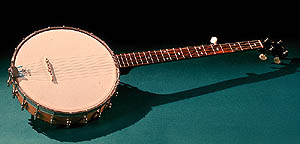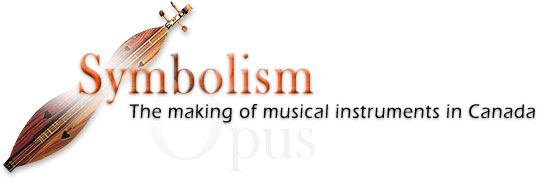|
|
 |
 he
banjo is a modern adaptation of an instrument played by west African
slaves in the New World beginning in the seventeenth century. In
Martinique, among other countries, it was associated with the
calinda dance, which was later banned by the settlers. The banjo was popularized
by black minstrels in the United States in the early twentieth century and
subsequently marketed in its present form in the United States and England. he
banjo is a modern adaptation of an instrument played by west African
slaves in the New World beginning in the seventeenth century. In
Martinique, among other countries, it was associated with the
calinda dance, which was later banned by the settlers. The banjo was popularized
by black minstrels in the United States in the early twentieth century and
subsequently marketed in its present form in the United States and England.
| |

Banjo
By
Thomas Dorward
Halifax, Nova Scotia
1974
Maple, walnut, rosewood, abalone,
mother-of-pearl, plastic, metal
Overall length: 90 cm;
diameter of body: 29 cm;
sides: 7 cm
|
The frame of this banjo is made of maple plywood,
and the neck of maple and walnut plywood, decorated on the back with a double
purfling. The peg box is shaped like a stylized violin.
Thomas Dorward
Thomas Dorward was born and grew up in Denver, Colorado. He built his first
instrument, a classical guitar, when he was still in high school and had
already made three guitars by the time he entered the University of
Michigan to study psychology. During his three years of studies, he repaired
and constructed musical instruments. In 1969, he enrolled at Dalhousie
University to develop his skill and made several types of instruments,
including guitars, Appalachian dulcimers and banjos. Shortly after
his graduation, he and his wife, Marla, opened the Halifax Folklore Centre
to buy, sell, trade, repair and construct stringed instruments; they later
broadened their scope to include a large amount of repair work on instruments
of the violin family. For fifteen years or so, Thomas Dorward has been
particularly interested in making archtop instruments; he has
also added the American A-Style Mandolin to his line of instruments. |




